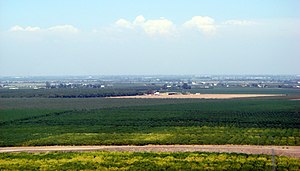 Image via Wikipedia
Image via WikipediaFor those of us in California's San Joaquin Valley, air quality is a major issue. Due to the bowl shape of this valley, pollution tends to get trapped and can contribute to respiratory difficulties, and even death, for both children and adults. So naturally we take pollution seriously here.
We also have a 15% unemployment issue here as well. How are these linked?
Environmental regulations, taxes, and government bureaucracy and red tape from the State of California and the Federal Government put a huge strain on business here in the Central Valley. We all want clean air, but we also need to put people back to work. Excessive regulation only compounds the difficulties that businesses and farmers face.
Now we find that the California Air Resources Board has been over-estimating diesel pollution by 340%! Since they use these numbers to develop and enact regulations, levy fines and God knows what else, how many jobs has this cost the Valley. How much money has it cost business, farms, and families? What other pollutants are they "over-estimating", and is this the result of honest mistakes, or is there something else afoot here? 340% is not insignificant, and this should be investigated to find out if these "rounding errors" are widespread, and how much this is costing the people of the San Joaquin Valley in jobs, and unnecessary taxes and regulations.
A Few Rounding Errors Amongst Friends
(H/T: The Minority Report)
What does cause tremendous health affects is unemployment.
– Dr. James Enstrom (HT: Martinezgazette.com)
The California Air Resources Board (CARB) has been caught making environmental policy based on badly flawed and intentionally dishonest estimates of PM2.5 pollution admissions. How bad is bad? Try a 340% overestimation of diesel particulate pollution levels? No way? Way!!
The pollution estimate in question was too high – by 340 percent, according to the California Air Resources Board, the state agency charged with researching and adopting air quality standards. The estimate was a key part in the creation of a regulation adopted by the Air Resources Board in 2007, a rule that forces businesses to cut diesel emissions by replacing or making costly upgrades to heavy-duty, diesel-fueled off-road vehicles used in construction and other industries.
(HT: San Francisco Gate)
The CARB staff blames this “oversight” on the recession and the resulting termination of many construction projects. Independent reviewers argue that applying the current methodology to existing data still gives terribly inaccurate results. The data then was used to produce the predictable Malthusian Scare Statistics. 18,000 premature deaths per year were attributed to diesel emissions according to the 340% inaccurate research. This has since been revised downward, after the monies were expropriated from construction firms operating diesels, to 9,200.
Given the intelligent and diligent people that work at CARB, this should surprise everyone. Well, ok, whom am I kidding? Maybe it shouldn’t. According to Dr. James Enstrom of UCLA and others who offered a 100 page critique of the “science” used by CARB, the regulatory commission was not exactly fielding the varsity when it undertook the analysis to support the regulations.
The year-long process of development of the new regulations resulted in some very revealing public commentary, accusations of complicity in the scientific review process, and even misconduct by CARB officials.
In the biggest scandal, opposition scientists found the lead author of the key study by CARB had faked his Ph.D. and lacked expertise in air pollution research. In addition, CARB hired reviewers to review their own papers, naturally resulting in approval of the scientific studies that claimed the death and health effects.
(HT: The Heartland Institute)
READ MORE:

7390.....47665
ReplyDeleteI think, that you commit an error. I can prove it.
ReplyDeleteThe author is really cool. But some of the commentators are just posting stupid words.
ReplyDelete